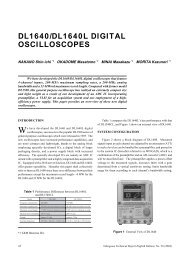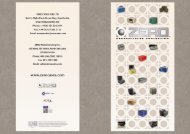2017-8-1_stip_final-508ed
You also want an ePaper? Increase the reach of your titles
YUMPU automatically turns print PDFs into web optimized ePapers that Google loves.
NASA Strategic Technology Investment Plan<br />
Examples of Enhancing Technologies:<br />
Radioisotope (TA 3.1.4)<br />
Radioisotope power systems (RPS) have been in use for decades and are configured<br />
to provide power for sophisticated NASA science missions. Deep space mission, for<br />
example, rely on the long life and reliability of RPS for operation in environments<br />
where conventional power systems are not feasible. A key goal for this enhancing<br />
technology is increased overall power conversion efficiency and reduced degradation<br />
for increased performance at destination. Higher power systems (200-500W) will be<br />
required for future missions, and improvements in thermoelectric and dynamic power<br />
conversion systems will be essential to reduce the overall use of plutonium 238. In<br />
addition, the development of compact mW power sources will enable the use of<br />
distributed sensor systems for the exploration of surface phenomenon on icy moons<br />
and other bodies of interest.<br />
Force and Tactile Sensing (TA 4.1.5)<br />
Force and tactile sensing provides feedback to help spacecraft and other robotic<br />
platforms interact more effectively with each other and with their environment. These<br />
types of sensors are increasingly common for terrestrial robotics applications, and<br />
space-qualified versions will have significant value for NASA’s missions. These<br />
sensors will help to improve general object grabbing tasks in space. The ability to<br />
reduce the size and cost of these senors will help to increase their availablity and<br />
possible applications.<br />
Power Efficient Technologies (TA 5.2.2)<br />
Spacecraft power systems must provide sufficient power for radio frequency<br />
communications. Power-efficient technologies that reduce the power required for radio<br />
frequency communication can help benefit other spacecraft systems and the overall<br />
missions design. Efficiency improvements for traveling wave tube amplifiers and solidstate<br />
power amplifiers will help reduce power demand. Data compression, coding, and<br />
modulation are other ways this enhancing technology can help achieve requirements<br />
for lower power demand.<br />
Destination Reconnaissance, Prospecting, and Mapping (TA 7.1.1)<br />
Destination reconnaissance, prospecting, and mapping will be needed for in-situ<br />
resource utilization at future destinations. Technologies are needed that can provide<br />
improved characterization of geotechnical and physical properties, mineralogy, and<br />
chemistry at exploration destinations. By improving characterization of mission<br />
destinations, mission planners can minimize risks and better optimize the performance<br />
of various destination systems.<br />
Flexible Material Systems (TA 12.1.3)<br />
Various types of flexible materials are being explored to provide benefits and improved<br />
capabilities for missions. Flexible materials can help with storage and deployment of<br />
systems and may offer advantages over ridged metal or composite structures.<br />
Structural textiles and lightweight flexible materials must provide reliability and integrity<br />
for long-duration missions.<br />
30







